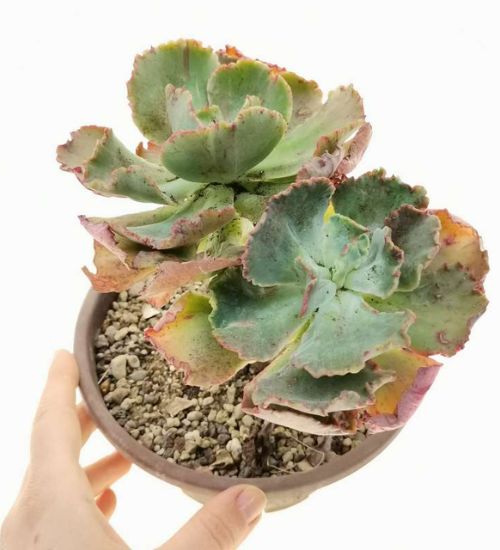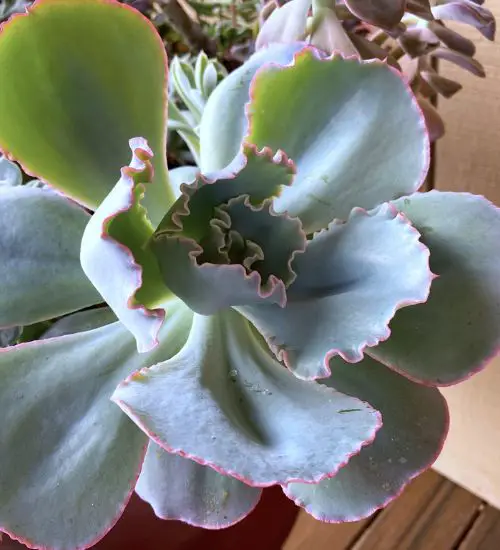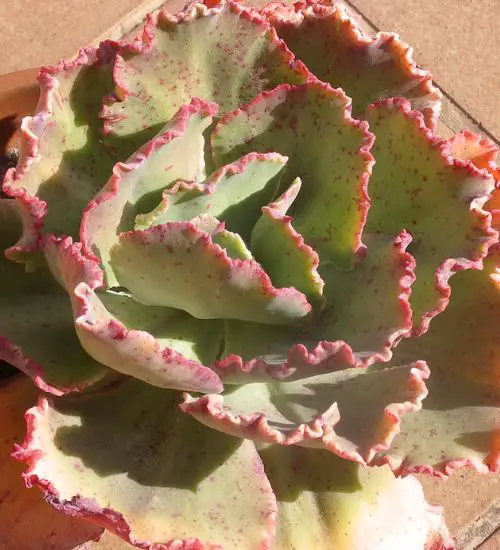Sun: full sun to partial shade
Water: Typical water needs for a succulent
Temperature: Zone 9b from 25° F to 30° F (-3.9° C to -1.1° C) to Zone 11b from 45° F to 50° F (7.2° C to 10° C)
Winter Survival: Not cold hardy
Propagation: leaves, offsets
Flower: Unknown - Tell us
Flower Type: Showy
Toxic: Generally non-toxic to humans and animals
Dormant: Unknown - Tell us
Space Requirement: Indoors & Outdoors
Common Problems: No major pests
Basc Care for Echeveria ‘Harry Butterfield'
Watering
What you need to remember is that this type of succulents needs to be watered for every 2 weeks
One simple tip for you is that you can use some online apps to check the soil status before you go water your succulents. I would recommend the ThePlantsCheck app, it has some nice features there.
Fertilizing
Only feed this succulent during its active growing seasons which means winter. Use the right fertilizer applied in the right amounts. Applying half-strength balanced fertilizer every month or so is recommended for optimal results.
Do not fertilize during Unknown - Tell us as the plant is dormant.
Sun & Location Requirements for "Echeveria ‘Harry Butterfield'"
Echeveria ‘Harry Butterfield' requires full sun to partial shade. It's best to keep it in an area of your garden or home that gets plenty of bright, indirect sunlight throughout the day. When temperatures are too hot and direct sunlight is too intense, try moving Echeveria ‘Harry Butterfield' to a shadier spot for part of the day.
Echeveria ‘Harry Butterfield' is not cold hardy and does not survive in freezing conditions. However, there are certain strategies that can be used to help the plant thrive despite the chill of winter. Proper drainage and insulation are essential for succulent X during periods of extreme cold. Placing a layer of mulch or gravel on the soil around the plant can also help keep it warm.
Any succulents in the group will need a medium space to grow. You can place your pot at your table or window. Since this plant needs more space than mini succulents, you should consider do not plant them together with other succulents/plants.
Echeveria ‘Harry Butterfield' also benefits from some indirect light throughout the day as well, so make sure you give it enough space to soak up light without becoming too exposed to heat.
Propagation
Propagating succulents by leaves is a great way to grow new plants from existing ones. Simply cut off a few healthy leaves from the mother plant and place them on top of a potting mix. Water the soil regularly, keeping it moist but not soggy, and soon you'll have brand new succulents!
Succulents can be propagated easily by taking offsets from the mother plant and replanting them in fresh soil. The offset will eventually grow into a new succulent that is identical to its parent.
Toxicity

Echeveria ‘Harry Butterfield' is not known to pose any significant health risks, as it is not considered to be toxic. However, it is best to keep the plant away from young children and pets, as they may ingest some of the parts of this plant that could contain toxins which can cause mild skin irritation.
Pests and Diseases
Echeveria ‘Harry Butterfield' is not affected too much by common pests and diseases like most of the other succulents.


